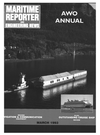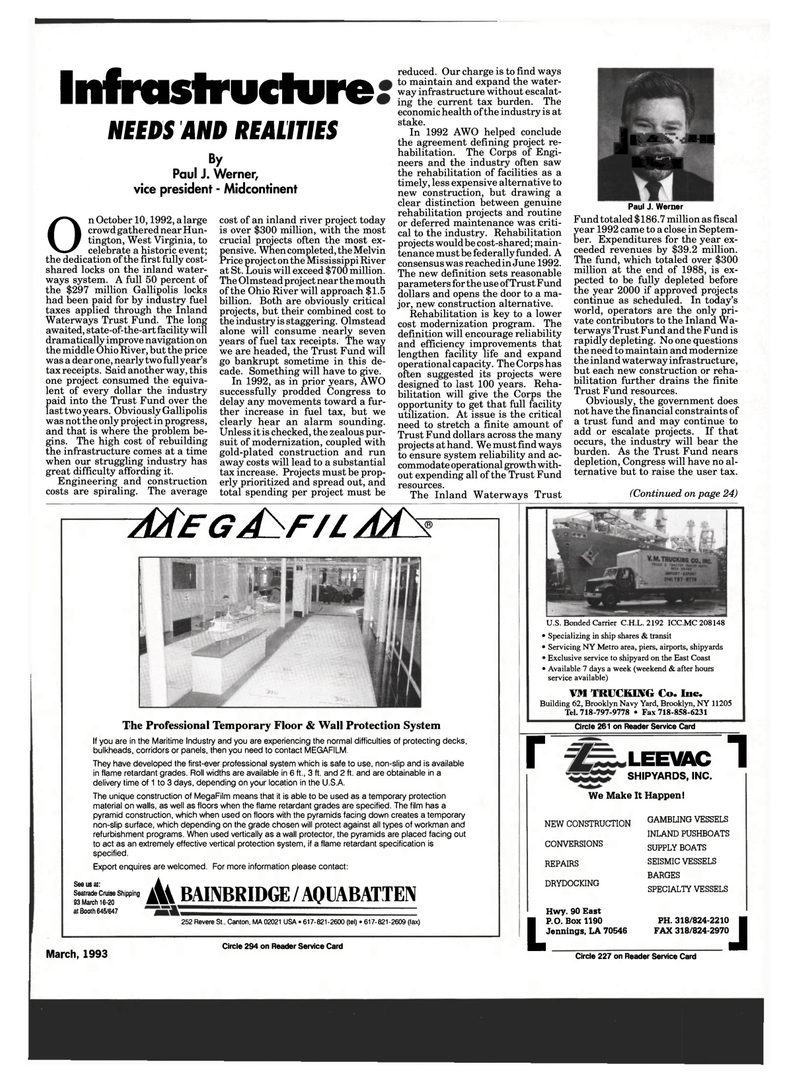
Page 21: of Maritime Reporter Magazine (March 1993)
Read this page in Pdf, Flash or Html5 edition of March 1993 Maritime Reporter Magazine
Infrastructure
NEEDS AND REALITIES
By
Paul J. Werner, vice president - Midcontinent
On October 10,1992, a large crowd gathered near Hun-tington, West Virginia, to celebrate a historic event; the dedication of the first fully cost- shared locks on the inland water- ways system. A full 50 percent of the $297 million Gallipolis locks had been paid for by industry fuel taxes applied through the Inland
Waterways Trust Fund. The long awaited, state-of-the-art facility will dramatically improve navigation on the middle Ohio River, but the price was a dear one, nearly two full year's tax receipts. Said another way, this one project consumed the equiva- lent of every dollar the industry paid into the Trust Fund over the last two years. Obviously Gallipolis was not the only project in progress, and that is where the problem be- gins. The high cost of rebuilding the infrastructure comes at a time when our struggling industry has great difficulty affording it.
Engineering and construction costs are spiraling. The average cost of an inland river project today is over $300 million, with the most crucial projects often the most ex- pensive. When completed, the Melvin
Price project on the Mississippi River at St. Louis will exceed $700 million.
The Olmstead proj ect near the mouth of the Ohio River will approach $1.5 billion. Both are obviously critical projects, but their combined cost to the industry is staggering. Olmstead alone will consume nearly seven years of fuel tax receipts. The way we are headed, the Trust Fund will go bankrupt sometime in this de- cade. Something will have to give.
In 1992, as in prior years, AWO successfully prodded Congress to delay any movements toward a fur- ther increase in fuel tax, but we clearly hear an alarm sounding.
Unless it is checked, the zealous pur- suit of modernization, coupled with gold-plated construction and run away costs will lead to a substantial tax increase. Projects must be prop- erly prioritized and spread out, and total spending per project must be reduced. Our charge is to find ways to maintain and expand the water- way infrastructure without escalat- ing the current tax burden. The economic health of the industry is at stake.
In 1992 AWO helped conclude the agreement defining project re- habilitation. The Corps of Engi- neers and the industry often saw the rehabilitation of facilities as a timely, less expensive alternative to new construction, but drawing a clear distinction between genuine rehabilitation projects and routine or deferred maintenance was criti- cal to the industry. Rehabilitation projects would be cost-shared; main- tenance must be federally funded. A consensus was reached in June 1992.
The new definition sets reasonable parameters for the use of Trust Fund dollars and opens the door to a ma- jor, new construction alternative.
Rehabilitation is key to a lower cost modernization program. The definition will encourage reliability and efficiency improvements that lengthen facility life and expand operational capacity. The Corps has often suggested its projects were designed to last 100 years. Reha- bilitation will give the Corps the opportunity to get that full facility utilization. At issue is the critical need to stretch a finite amount of
Trust Fund dollars across the many projects at hand. We must find ways to ensure system reliability and ac- commodate operational growth with- out expending all of the Trust Fund resources.
The Inland Waterways Trust 1 | JL - fj A 6t fs^ M
Paul J. Werner
Fund totaled $186.7 million as fiscal year 1992 came to a close in Septem- ber. Expenditures for the year ex- ceeded revenues by $39.2 million.
The fund, which totaled over $300 million at the end of 1988, is ex- pected to be fully depleted before the year 2000 if approved projects continue as scheduled. In today's world, operators are the only pri- vate contributors to the Inland Wa- terways Trust Fund and the Fund is rapidly depleting. No one questions the need to maintain and modernize the inland waterway infrastructure, but each new construction or reha- bilitation further drains the finite
Trust Fund resources.
Obviously, the government does not have the financial constraints of a trust fund and may continue to add or escalate projects. If that occurs, the industry will bear the burden. As the Trust Fund nears depletion, Congress will have no al- ternative but to raise the user tax. (Continued on page 24)
Meg^F/L M^
The Professional Temporary Floor & Wall Protection System
If you are in the Maritime Industry and you are experiencing the normal difficulties of protecting decks, bulkheads, corridors or panels, then you need to contact MEGAFILM.
They have developed the first-ever professional system which is safe to use, non-slip and is available in flame retardant grades. Roll widths are available in 6 ft., 3 ft. and 2 ft. and are obtainable in a delivery time of 1 to 3 days, depending on your location in the U.S.A.
The unique construction of MegaFilm means that it is able to be used as a temporary protection material on walls, as well as floors when the flame retardant grades are specified. The film has a pyramid construction, which when used on floors with the pyramids facing down creates a temporary non-slip surface, which depending on the grade chosen will protect against all types of workman and refurbishment programs. When used vertically as a wall protector, the pyramids are placed facing out to act as an extremely effective vertical protection system, if a flame retardant specification is specified.
Export enquires are welcomed. For more information please contact:
See us at:
Sealrade Cruise Shipping 93 March 16-20 at Booth 645/647
AVBAINBRIDGE /AQLABATTEN 252 Revere St., Canton, MA 02021 USA • 617-821-2600 (tel) • 617-821-2609 (fax)
U.S. Bonded Carrier C.H.L. 2192 ICC.MC 208148 • Specializing in ship shares & transit • Servicing NY Metro area, piers, airports, shipyards • Exclusive service to shipyard on the East Coast • Available 7 days a week (weekend & after hours service available)
XM TRUCKJCVG Co. Inc.
Building 62, Brooklyn Navy Yard, Brooklyn, NY 11205
Tel. 718-797-9778 • Fax 718-858-6231
Circle 261 on Reader Service Card r
LEEVAC
SHIPYARDS, INC.
We Make It Happen! 1
NEW CONSTRUCTION
CONVERSIONS
REPAIRS
DRYDOCKING
GAMBLING VESSELS
INLAND PUSHBOATS
SUPPLY BOATS
SEISMIC VESSELS
BARGES
SPECIALTY VESSELS
March, 1993 Circle 294 on Reader Service Card ] L Hwy. 90 East
P.O. Box 1190
Jennings, LA 70546
PH. 318/824-2210
FAX 318/824-2970
Circle 227 on Reader Service Card
J

 20
20

 22
22
